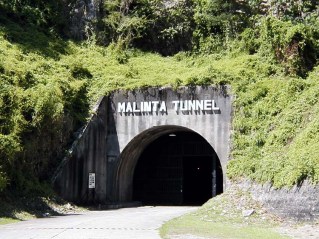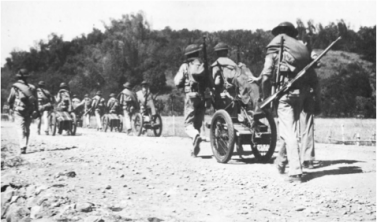 The 4th Marines moved out of its barracks after the Japanese attack on 29 December; it was safer in the field. 1st Battalion, 4th Marines assumed responsibility for the eastern sector (Manila Hill to Hooker Point) on the tail-end of the island; 2nd Battalion, 4th Marines moved to the western sector, and the provisional battalion assigned to the middle section of the island. On 1 January 1942, the 1st Separate Marine Battalion was officially renamed 3rd Battalion, 4th Marines. None of the Marine commanders were kidding themselves. There was no way that a battalion of 350 men could defend a sector of beach extending from between 3,500 to 4,000 yards. Still, the Marines began constructing barbed wire barriers, tank traps, and a system of trenches. When the Marines ran out of sandbags, they improvised with powder cans. Marines also filled bottles with gasoline, intending to drop them on top of landing Japanese forces from their positions in the cliffs of Malinta Hill. They also constructed wooden chutes from which the Marines intended to drop aircraft bombs on the Japanese.
The 4th Marines moved out of its barracks after the Japanese attack on 29 December; it was safer in the field. 1st Battalion, 4th Marines assumed responsibility for the eastern sector (Manila Hill to Hooker Point) on the tail-end of the island; 2nd Battalion, 4th Marines moved to the western sector, and the provisional battalion assigned to the middle section of the island. On 1 January 1942, the 1st Separate Marine Battalion was officially renamed 3rd Battalion, 4th Marines. None of the Marine commanders were kidding themselves. There was no way that a battalion of 350 men could defend a sector of beach extending from between 3,500 to 4,000 yards. Still, the Marines began constructing barbed wire barriers, tank traps, and a system of trenches. When the Marines ran out of sandbags, they improvised with powder cans. Marines also filled bottles with gasoline, intending to drop them on top of landing Japanese forces from their positions in the cliffs of Malinta Hill. They also constructed wooden chutes from which the Marines intended to drop aircraft bombs on the Japanese.
A few Marines remained on the Bataan peninsula, however, and the dispute between General MacArthur and Admiral Rockwell continued over who owned these Marines and how they would be assigned. Two antiaircraft batteries in the Mariveles area formed part of a naval defense battalion assigned to the southern coast of Bataan. When MacArthur learned of these Marines, he ordered one battery to serve as a guard force for USAFFE headquarters, but the battalion commander, Commander Frank J. Bridget countermanded the order and directed the Battery A commander to return to duty at Mariveles. Undeterred, MacArthur wrote directly to Admiral Rockwell requesting suspension of Commander Bridget’s order. Rockwell refused, informing MacArthur that these Marines had not been released to Army control. MacArthur ended the dispute by ordering two officers and forty Marines from Corregidor to serve as guards for USAFFE.
The Japanese made an amphibious landing at Langoskawayan Point on 23 January 1942, some 2,000 yards west of Mariveles. Commander Bridget ordered the commanders of Battery A and Battery C to send patrols to the Point, confirm the landing, and set up a blocking force if necessary. Commander Bridget did not let the battery commanders know that he had issued orders to each; now there were two Marine patrols hunting for Japanese, neither one aware of the presence of the other. Then Commander Bridget organized a hastily gathered platoon of 36 sailors and placed them under the command of Platoon Sergeant Robert A. Clement, who was ordered to “support” his two Marine Corps lieutenants. By hastily formed platoon, I mean that these sailors did not know how to load their rifles with ammunition. Clement held school for individuals unfamiliar with their weapons, and then he pushed on. Clement and his platoon triggered a Japanese ambush a short while later —the firing alerted the two Marine patrols of the presence of other assets. The Marines continued to probe, finding strong Japanese resistance; they soon realized that they didn’t have enough Marines to handle these Japanese troops.
 The Japanese were professional in their conduct, and exceedingly aggressive. They not only moved forward, they sent out patrols to locate the American Marines, and they set up ambushes, inflicting heavy losses. So few Marines could not afford heavy losses. Lieutenant Holdredge and eleven Marines from Battery C were wounded in one early confrontation with the Japanese; one Marine was killed. Whenever the Marines attacked the Japanese, the Japanese put up a vigorous defense and then counterattacked; Lieutenant Hogaboom, commanding Battery A reported to Commander Bridget, “We cannot hold our ground with so few troops.” Bridget was not empathetic; he ordered Hogaboom to dig in for the night and prepare for another attack at first light. Fortunately for these few Marines, the 1st Battalion, 57th Infantry (Philippine Scouts) relieved the Marines during the night permitting Bridget to withdraw his battalion to Mariveles. It took the Philippine Scouts three days to destroy the Japanese landing force, a reinforced battalion.
The Japanese were professional in their conduct, and exceedingly aggressive. They not only moved forward, they sent out patrols to locate the American Marines, and they set up ambushes, inflicting heavy losses. So few Marines could not afford heavy losses. Lieutenant Holdredge and eleven Marines from Battery C were wounded in one early confrontation with the Japanese; one Marine was killed. Whenever the Marines attacked the Japanese, the Japanese put up a vigorous defense and then counterattacked; Lieutenant Hogaboom, commanding Battery A reported to Commander Bridget, “We cannot hold our ground with so few troops.” Bridget was not empathetic; he ordered Hogaboom to dig in for the night and prepare for another attack at first light. Fortunately for these few Marines, the 1st Battalion, 57th Infantry (Philippine Scouts) relieved the Marines during the night permitting Bridget to withdraw his battalion to Mariveles. It took the Philippine Scouts three days to destroy the Japanese landing force, a reinforced battalion.
Continued next week

Mustang! hey Bless you my loyal patriot friend now and always!..Blessed Memorial Day and eat tons of dessert..ha! 🙂 xoxoxoxox thank you for your service:)
LikeLike
Corregidor’s Marines definitely fit the mantra of “Improvise, adapt, overcome”: wooden chutes and beer bottles filled with gas. This was the first time I’ve read about MacArthur meddling in Naval/Marines affairs at a most inopportune time. Your info on how sailors supported the Marines on combat patrols helped me further accept some of the stories told me by Old Man Jack. (What rifles were issued? Springfields?).
Thank you.
LikeLike
The M1 didn’t get out to the fleet until late 1942.
LikeLiked by 1 person
Thank you.
LikeLike
Touched the wrong place on my tablet, sir. Wanted to write I thought each branch of the armed forces – except the Marines – had received shipments of the Garand in the 40’s. I guess it was primarily the Army.
LikeLike
While true the Garand was in production in 1939, the British gave it a very unflattering evaluation and this may have had a chilling effect on the production models and may have delayed replacement of the 1903A3. As it turns out, the British didn’t know what in the hell they were talking about. Any weapon will clog up if you shove enough mud into the chamber.
LikeLiked by 1 person
Phenomenal information and history, sir. And you mentioned the “M1A1”. Folding stock or just a spell check typo?
LikeLike
Stupid computer …
LikeLiked by 1 person
Yup!! 🙂
LikeLike